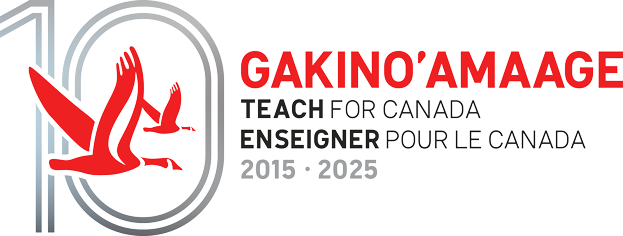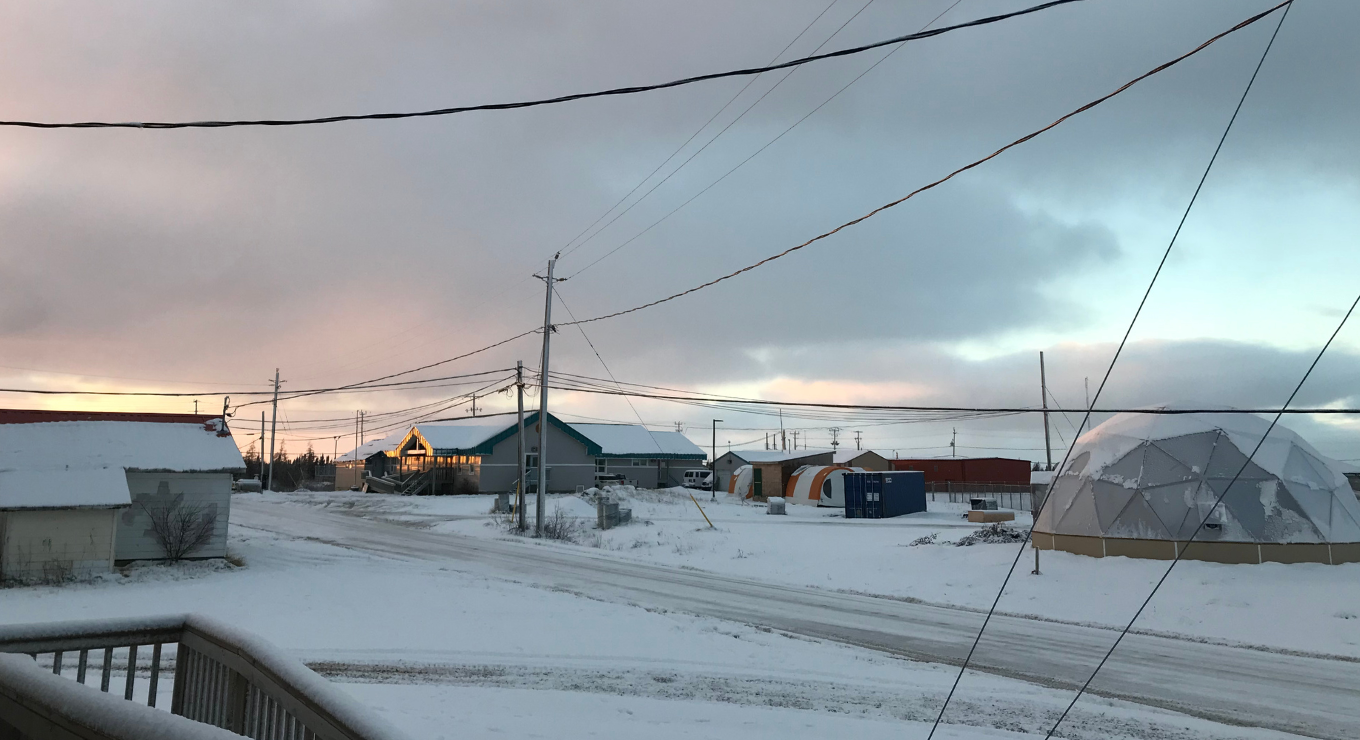Teach For Canada–Gakinaamaage offers in-classroom Teacher Development support to educators throughout their two-year commitment in the North. They receive professional, peer, and personal support, including funding to pursue additional qualifications, access to classroom resources, regular check-ins with their Teacher Development Managers, access to counselling services, and opportunities to connect with a dedicated network of Northern educators. These supports help to ensure success in the classroom and the community.
After several years of providing remote teacher support, our Teacher Development team has returned to in-person visits. Beginning in November 2022, we’ve made our way back into classrooms to see firsthand the amazing work and dedication of Northern educators.
In November, one of our Teacher Development Managers, Danielle Consitt, visited Fort Severn First Nation to provide in-classroom support to five Gakino’amaage: Teach For Canada teachers, three of whom teach at Wasaho Cree Nation School and two at Keewaytinook Internet High School (KiHS). While spending time in Taylor Lambie’s 5th and 6th Grade classroom, Danielle witnessed Healing Through Hip-Hop, a workshop led by special guest facilitator Shibastik.
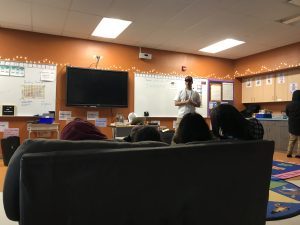
Shibastik teaches a Healing Through Hip Hop workshop to Gakino’amaage: Teach For Canada Teacher Taylor Lambie’s 5th and 6th Grade class in Fort Severn First Nation.
Taylor Lambie is a certified teacher and member of Gakino’amaage: Teach For Canada’s 2022 cohort. She accepted an offer to teach 5th and 6th Grade at Wasaho Cree Nation School in Fort Severn First Nation and is completing the first year of her two-year commitment.
Taylor expressed that the workshop led to increased participation from students who hadn’t previously shown enthusiasm for writing. Not only were participants expressing themselves in both Cree and English–there were multiple elements of the wider curriculum woven into the activity.
“The best lesson that came out of Shibastik’s visit was self-confidence. Students who are typically quiet and hesitant in class were engaged and participated in different ways.”
“Some helped create the beat, others shared lyrics, and a few even tried their hand at rapping in front of the class,” recalled Lambie.
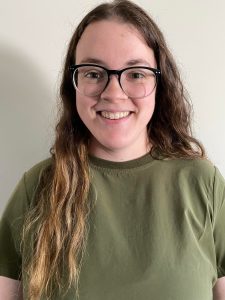
Taylor Lambie joined Gakino’amaage: Teach For Canada’s 2022 Cohort and accepted a position teaching 5th and 6th Grade at Wasayo Cree Nation School in Fort Severn First Nation.
Throughout the lesson, students were able to practice their reading, writing, listening, and comprehension skills and walked away with a better understanding of form and style, including the use of rhymes to link verses together. Because the lyrics were layered over music, the lesson also incorporated elements of numeracy.
Shibastik, Mushkego Cree for “underground flow,” is an accomplished rapper, hip-hop producer, painter, athlete, and a proud Moose Cree First Nation member. He was born in Moose Factory, Ontario, and grew up across the Moose River in Moosonee. He is a Native American Music Awards nominee.
For nearly twenty years, he has offered multiple programs geared toward engaging youth. His workshops, Healing Through Hip Hop, Fighting through PAINt, Hunting for Healing, and Hurt People, are grounded in Indigenous histories and knowledge and aim to create a healing space for students to express themselves.
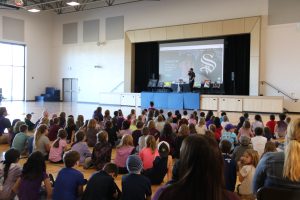
Shibastik regularly performs his workshops in First Nations schools across the country. Photo courtesy of Shibastik.
“For Healing Through Hip Hop, I bring a beat-making machine into the classroom. The students and I write music together, focusing on self-expression and addressing emotions. We work together to create a collaborative song.”
Shibastik says that when he was growing up, he had a hard time expressing himself until he discovered poems as a way of his sharing feelings with his family.
While he has lived in Thunder Bay, Ontario, for 16 years, his website lists over 50 First Nations across Turtle Island where he has offered his programs.
“I am from Moosonee. When I visit a First Nation, I feel like I am going home,” says Shibastik.
“There is so much that inspired me to start working with youth. I got into rapping because I wanted an outlet to address the serious issues going on in my community. Throughout my life, I have been affected by suicide and have lost many people close to me. Getting into music was a way of connecting with others–to share the beautiful side of living in a First Nation and educate through lyrics. I hope that my work helps to share the perspectives of people living in small northern communities.”
Shibastik has been told that he might not succeed due to his music’s focus on issues affecting many First Nations–including the effects of intergenerational trauma, histories of Canadian Indian Residential Schools, increased suicide rates, and access to clean water and healthy food–but that’s never bothered him. “I speak to my community,” he says.
“Something magic happens every time I facilitate a workshop, and each time it’s different. I have an outline, but the process is very spiritual to me. I remain open to my feelings and what I share. The most recent session I led was about sexual abuse and Residential Schools. These topics can be difficult to address, but it’s important that my workshops create platforms for children to open up.”
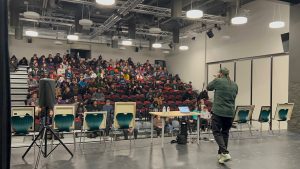
Shibastik integrates elements of spoken word, visual art, and education into his programming. Photo courtesy of Shibastik.
For Taylor Lambie, Shibastik’s visit to Fort Severn gave her students the gift of seeing themselves reflected in his art.
“My students don’t often get to see their lives, experiences, and cultures represented in the media or the world around them. They still talk about Shibastik and their songwriting session–and even sing their lyrics at times!”
When asked what message he would like to share with his community, Shibasik turned to the importance of preserving Indigenous knowledge.
“I want the people in Northern First Nations to realize how vital the information that they have is. Keep our traditions alive, and pass them on to the younger generations.”
“Even if we run into people who look down on us, we must remember that Indigenous education is important.”
“Lots of effort was put into trying to abolish Indigenous culture and change the ways that we live and interact with the land. We need to be brave. Today, we are being listened to, and the way to fight is different. We need to be warriors. Now is the time to use our words. I want to do what I can to help Indigenous voices be heard.”
Join teachers like Taylor Lambie in the movement to make education more equal. We’re accepting applications for certified teachers interested in teaching in the North. Learn more and apply now.


